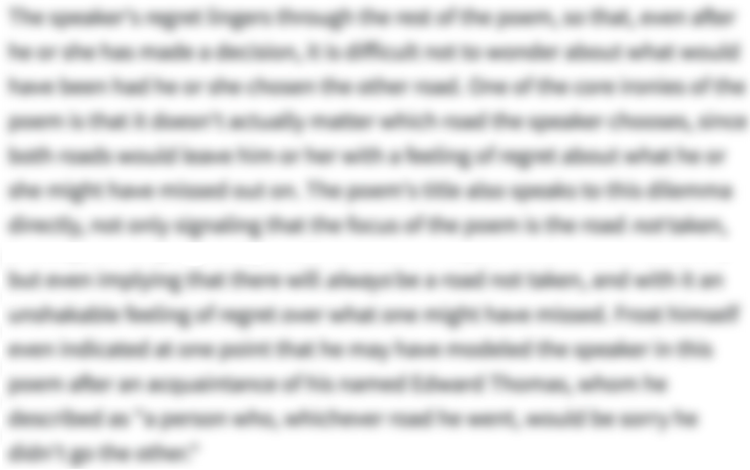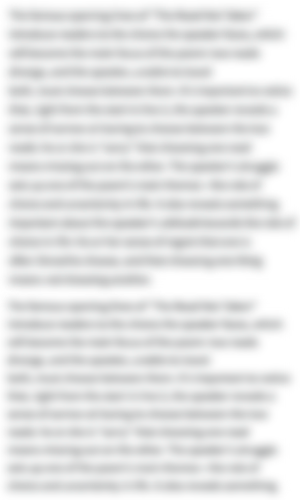The Full Text of “Morning at the Window”
1They are rattling breakfast plates in basement kitchens,
2And along the trampled edges of the street
3I am aware of the damp souls of housemaids
4Sprouting despondently at area gates.
5The brown waves of fog toss up to me
6Twisted faces from the bottom of the street,
7And tear from a passer-by with muddy skirts
8An aimless smile that hovers in the air
9And vanishes along the level of the roofs.
-
“Morning at the Window” Introduction
-
"Morning at the Window" is a short poem by T. S. Eliot, first published in the poet's 1917 collection Prufrock and Other Observations. Looking down on an urban street from a window (perhaps in London, where the poem was written), the speaker hears and sees down-trodden servants cheerlessly going about their morning chores. The air is filled with brown fog (a mark of pollution), through which the speaker catches glimpses of disembodied faces that appear twisted in pain or anguish. Modern city life, in this poem, is marked by stark class inequality, despair, and alienation.
-
-
“Morning at the Window” Summary
-
The speaker hears the clatter of plates as servants prepare breakfast in kitchens located in basements. They can sense the melancholy spirits of housemaids trudging down the well-worn sides of the street, after having emerged dejectedly from the gates of their respective houses.
Dingy swaths of fog roll by, now and then revealing the uncomfortable faces of the people on the street down below. A smile, ripped from someone wearing a dirty skirt, drifts up through the air before disappearing along the rooftops.
-
-
“Morning at the Window” Themes
-

Class, Alienation, and Modern Life
The speaker of "Morning at the Window" looks down onto a busy street, watching as "housemaids" and other service workers go about their morning business. Their faces are "twisted" and despondent, suggesting that these working-class people lead unhappy, difficult lives in a dingy, dismal urban setting. The single "smile" the speaker witnesses doesn't connect with anyone, including the speaker. Through briefly sketched details, the poem suggests that modern life—especially for those lower in the class system—is profoundly limiting and alienating.
The poem presents a street quite literally divided by class: while "housemaids" and kitchen staff live down there, the speaker has a privileged vantage point from a window above them. Servants work below the people they serve. They're presented as an anonymous "They" who "rattl[e] breakfast plates in basement kitchens" (preparing food for their employers). Housemaids emerge like poor "souls" from their underworld, "Sprouting despondently" at the gates, presumably to run some errand for their employers.
Life at the "bottom," the poem suggests, is tough. The housemaids have souls "damp[ened]" by their socio-economic position (which explains why they "Sprout[] despondently," rather than, say, "emerge jubilantly"). They don't really want to be there, in other words, but they have no choice.
The street's "brown waves of fog" and "trampled edges," meanwhile, add to the gloomy atmosphere, while the "muddy skirts" of a "passer-by" (possibly one of those housemaids) suggest poverty and neglect. The faces in the street look "Twisted" by anger, pain, etc. In fact, the references to "souls" and "Twisted faces" make this urban atmosphere sound downright hellish. In this setting, a single "smile" is an anomaly that catches the speaker's attention.
The divide between the speaker, who is likely of a higher class, and the people below reflects a broader sense of urban alienation. The poem suggests that modern city life, polluted by industry and stratified by the class system, prevents people from relating to each other.
"Waves of fog" ("brown[ed]" by city pollution) drift between the speaker and the people the speaker watches, obscuring them from one another. The "faces" below appear to the speaker as disembodied, "Twisted" images "toss[ed] up" by the fog. A passer-by's smile—normally a symbol of human intimacy and connection—has nowhere to go, hovering "aimless[ly]" before "vanish[ing] along the level of the roofs." In a way, the smile is able to rise to the speaker's height—but its owner, kept at a distance by the city's physical/social divisions, doesn't and can't. In short, this urban environment seems to prohibit genuine connection.
It's important to note that the poem doesn't go beyond sketch-like observation. That is, the speaker doesn't directly critique what they see; they just describe it. Their perspective is dependent on their physical and social position, making them a potentially biased narrator. The poem hints at a broader statement about modern urban alienation, but ultimately, its style is as murky, unresolvable, and fragmentary as the scene it depicts.
- See where this theme is active in the poem.
-
-
Line-by-Line Explanation & Analysis of “Morning at the Window”
-
Line 1
They are rattling breakfast plates in basement kitchens,
The poem's title sets the scene: it's early in the day ("morning"), and the speaker looks down on the world below from a high vantage point (the window).
The first line, though, describes a sound rather than a sight: the clinking and "rattling" of "breakfast places in basement kitchens." This auditory imagery drops the reader right into the middle of a scene without any preamble. It's almost as if the speaker is woken by the sound of "rattling breakfast plates," making this the first observation of their day.
The line itself is noisy, with bold /b/ alliteration and spiky /t/ and /k/ consonance evoking the "rattling" being described: "rattling breakfast plates in basement kitchens."
The fact that the servants are consigned to the basements, below the speaker, symbolizes their lower-class status. Notice, too, how the speaker doesn't start with a word like "servants" or "staff." Instead, the speaker just says "they." This distances the speaker (and the reader, for that matter) from the workers getting breakfast ready. These workers are an anonymous, indistinct group rather than individuals with their own agency and identity.
-
Lines 2-4
And along the trampled edges of the street
I am aware of the damp souls of housemaids
Sprouting despondently at area gates.

Unlock all 300 words of this analysis of Lines 2-4 of “Morning at the Window,” and get the Line-by-Line Analysis for every poem we cover.
Plus so much more...
Get LitCharts A+ -
Lines 5-6
The brown waves of fog toss up to me
Twisted faces from the bottom of the street, -
Lines 7-9
And tear from a passer-by with muddy skirts
An aimless smile that hovers in the air
And vanishes along the level of the roofs.
-
-
“Morning at the Window” Symbols
-

The Divide Between the Window and the Street
While the speaker (and, implicitly, the street's wealthier inhabitants) reside on high, the servants are consigned to the street and "basement kitchens" below. This vertical divide neatly represents the societal divide between upper and lower classes, or between the haves and have-nots: those with money and leisure time and those struggling just to get by.
The physical distance between these realms allows the upper class to dehumanize the workers below. Note how the speaker presents those "twisted faces," the "aimless smile," and the housemaids' "damp souls" as though they exist independently of actual human beings. The lower classes are an anonymous "they" from the speaker's vantage point.
- See where this symbol appears in the poem.
-
-
“Morning at the Window” Poetic Devices & Figurative Language
-
Consonance
Consonance and alliteration add to the poem's gloomy morning atmosphere.
In the first line, the strong /b/ alliteration of "breakfast" and "basement" combines with the spiky consonance of /t/ and /k/ sounds to evoke the clang and clamor that the speaker describes:
They are rattling breakfast plates in basement kitchens,
Hissing /s/ sounds and the plosive /p/ of "plates" add to the effect, creating a cacophonous and intense opening. Perhaps all this noise from the kitchen has woken the speaker up!
Sibilance and crisp /t/ consonance dominate the rest of the poem, as in lines 3-8:
[...] souls of housemaids
Sprouting despondently at area gates.The brown waves of fog toss up to me
Twisted faces from the bottom of the street,
And tear from a passer-by with muddy skirts
An aimless smile [...]This spitting mixture of sounds might convey the speaker's distaste for the scene at hand. Those /t/ sounds are sharp and crisp, while the quiet sibilance evokes the way those "brown waves of fog" seem to muffle, or put a damper, on life on the street.
- See where this poetic device appears in the poem.
-
Enjambment


Unlock all 230 words of this analysis of Enjambment in “Morning at the Window,” and get the poetic device analyses for every poem we cover.
Plus so much more...
Get LitCharts A+ -
Imagery
-
Juxtaposition
-
-
“Morning at the Window” Vocabulary
Select any word below to get its definition in the context of the poem. The words are listed in the order in which they appear in the poem.
- Trampled
- Sprouting
- Despondently
- Area gates
- Toss up
Trampled-
Worn down by footsteps.
- See where this vocabulary word appears in the poem.
-
Form, Meter, & Rhyme Scheme of “Morning at the Window”
-
Form
"Morning at the Window" consists of a quatrain (a four-line stanza) followed by a quintain (a five-line stanza). Each stanza is also a single, sprawling sentence, making it feel as though readers are getting access to the speaker's unfiltered, in-the-moment thoughts.
The poem's brevity also makes it feel like a snapshot, offering a quick yet striking impression of a city morning. In this way, the poem fits within the formal tendencies of Imagist poetry, an influential literary movement of the early 20th century that dovetailed with modernism. Imagist poets sought to capture vivid scenes in precise language, which is exactly what Eliot does here.
-
Meter
"Morning at the Window" doesn't use a strict meter. That said, it's not entirely free verse either.
That's because most of the lines here have five stresses (or so), and these stresses sometimes fall into a steady iambic pattern (da-DUM). As such, the poem approaches iambic pentameter at times. The poem is thus a kind of hybrid between free verse, iambic pentameter, and accentual meter. This mixture of formal meter and linguistic looseness suits the poem's air of detachment mixed with astute observation.
The last two lines—iambic pentameter and hexameter (six feet) respectively—are the most regular in the poem:
An aim- | less smile | that ho- | vers in | the air
And van- | ishes | along | the le- | vel of | the roofs.These two lines seem to conjure both momentum and monotony at the same time. That disembodied smile is on the move, yet it's also going nowhere. Augustan poet Alexander Pope famously said that a line of iambic hexameter (a.k.a an alexandrine) "drags its slow length along." And that long, plodding final line ends the poem in a way that subtly captures the drudgery of urban life.
-
Rhyme Scheme
"Morning at the Window" doesn't use a rhyme scheme. There's a hint of rhyme between "housemaids" and "gates" in lines 3-4 and then between "me" and "street" in lines 5-6, but that's about it! The lack of rhyme makes the poem feel casual and semi-improvised, as though it is taking place in real time and prioritising observational detail over technical virtuosity.
-
-
“Morning at the Window” Speaker
-
"Morning at the Window" uses a first-person speaker who, as the title suggests, is looking out of a window and observing the street below. The whole poem is filtered through the speaker's perspective, yet the reader learns almost nothing about this person.
What readers can guess is that the speaker is relatively well off, at least compared to the housemaids and servants preparing breakfast "in basement kitchens." For one thing, the speaker has time to watch these workers rather than immediately heading off to work themselves. The speaker's physical location above the street also suggests, on a symbolic level, that they occupy a higher social rung—that they're more upper class—than the figures they observe far below.
As such, readers might take the speaker's observations with a grain of salt. The speaker sees the people they describe only from a distance, and their perception of lower-class life is undoubtedly informed by their own experiences.
-
-
“Morning at the Window” Setting
-
As the poem's title reveals, "Morning at the Window" takes place at the speaker's window in the morning! More specifically, it's set in a grungy urban environment very early in the day, with the speaker looking out their window at the happenings on the muddy street far below.
Some critics have suggested that the poem was written about London's Russell Square (where Eliot lived for a time), though the poem doesn't offer much by way of specifics. The speaker's observations do suggest, however, that this is a well-off neighborhood. For one thing, there are servants and housemaids hard at work early in the morning. It's also foggy, as London often is.
The fact that this fog rolls past in "brown waves" suggests that it's tinged with pollution. It also obscures the faces of the people below, adding to the sense that modern life is marked by isolation and alienation; there are lots of people present, but they don't really see each other.
The speaker themselves isn't at street level. Instead, they have a privileged vantage point high up above the workers going about their errands. The poem's setting is thus symbolic, representing the stark class divide between the haves and the have-nots.
-
-
Literary and Historical Context of “Morning at the Window”
Literary Context
T. S. Eliot (1888-1965) most likely wrote "Morning at the Window" in London in 1914 or 1915, during a period of great literary experimentation known as modernism. Modernist writers challenged the established literary norms inherited from the 19th century. These norms were both formal—that is, related to the actual way that poems, plays, and novels were expected to be written—and social: sex, drugs and alcohol, feminism, and working-class life all became new subjects for serious literature during this period.
"Morning at the Window" came early in Eliot's literary career, published in his first collection, Prufrock and Other Observations (1917). The collection's long title poem, "The Love Song of J. Alfred Prufrock," expands on the dismal take on urban life, class, and society expressed in "Morning at the Window."
Eliot's models at this time were mainly French Symbolist poets of the late 19th century, such as Jules Laforgue and Stéphane Mallarmé. Symbolism was a movement that rejected Realism in art; instead, it tried to symbolize psychological states through descriptions of the world itself.
In capturing a particular set of observations at a particular moment in time, without giving them a neat form or meaning, "Morning at the Window" also reflects the tenets of Imagist poetry. Imagism refers to a loose-knit movement that encouraged direct, to-the-point language and clear, precise imagery. "In a Station of the Metro," by Eliot's friend and leading Imagist poet Ezra Pound, captures a similar sense of metropolitan decay and alienation.
Eliot's influence on Western literary culture can hardly be overstated, with poems like "The Waste Land" and "Four Quartets" casting a long shadow over 20th-century writing.
Historical Context
The early 20th century was a time of immense change. Inventions such as the airplane and telephone altered people's lives immensely in a short space of time, while cities grew denser as more and more people began moving from the countryside to urban centers. New technologies and industries improved the quality of life for many people while also contributing to widespread pollution and unsafe working conditions.
When poems from Prufrock and Other Observations were first printed, World War I had just begun. The immense violence of the "Great War" shook ideals inherited from the previous century and shattered the old European order. The new technologies that had seemingly improved life for so many were used to kill on an industrial scale.
This made modernist artists deeply skeptical of the modern world—hence the critical depiction of the city in "Morning at the Window." At the same time, though, modernist thinking stirred up animosity towards older ways of living; after all, it was the old European empires that had led the continent into war.
-
More “Morning at the Window” Resources
-
External Resources
-
London's Russell Square — Learn more about the place that some critics believe inspired the poem's setting.
-
The Poem Out Loud — Hear "Morning at the Window" read by T. S. Eliot himself.
-
Prufrock and Other Observations — Read the entire collection in which "Morning at the Window" appears.
-
T. S. Eliot's Life and Work — Check out a biography of Eliot with links to more of his writings at the Poetry Foundation.
-
-
LitCharts on Other Poems by T. S. Eliot
-








